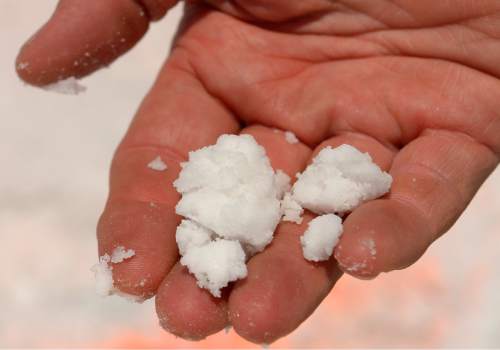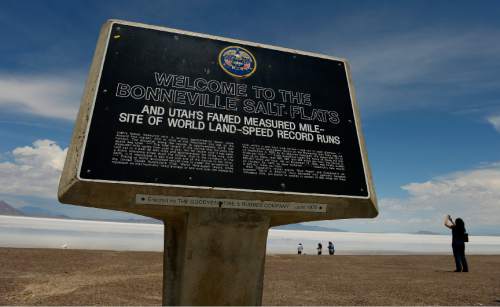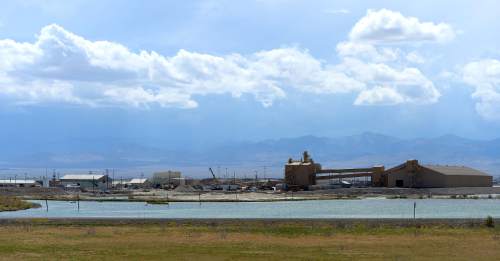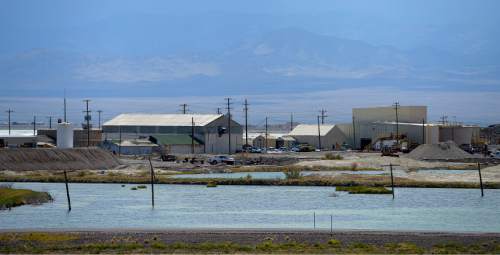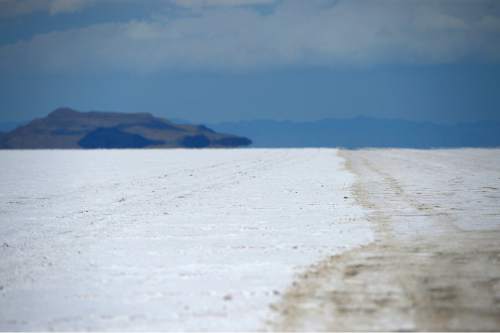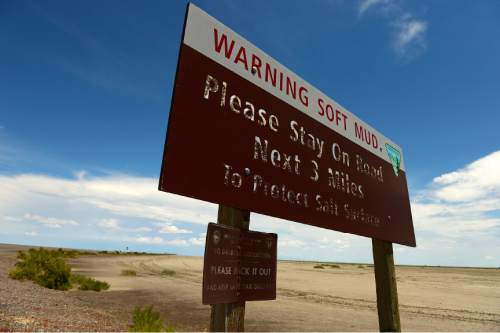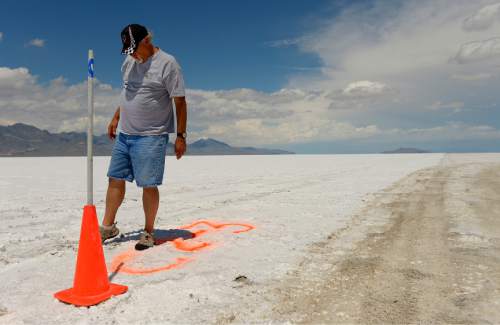Leah Hogsten | The Salt Lake Tribune
There are four "courses" on the Bonneville Salt Flats used by the Utah Salt Flats
Leah Hogsten | The Salt Lake Tribune
Although visitors to the I-80 rest stop learn about the salt flats' racing history and get
Leah Hogsten | The Salt Lake Tribune
Heavy down pouring of rain in July left standing water on the salt flats, Wednesday, July 9
Leah Hogsten | The Salt Lake Tribune
Although it used to be too salty for any vegetation to grow on the flats, sagebrush has spr
Leah Hogsten | The Salt Lake Tribune
In preparation for this weekend's "Test and Tune" races held by the Utah Salt Fla
Leah Hogsten | The Salt Lake Tribune
Dennis Sullivan, president of the Utah Salt Flats Racing Association or USFRA holds popcorn
Leah Hogsten | The Salt Lake Tribune
Although visitors to the I-80 rest stop learn about the salt flats' racing history and get
Leah Hogsten | The Salt Lake Tribune
The Intrepid Potash, Inc., operates two plants in Utah, one in Moab and the other across fr
Leah Hogsten | The Salt Lake Tribune
The Intrepid Potash, Inc., operates two plants in Utah, one in Moab and the other across fr
Leah Hogsten | The Salt Lake Tribune
The Intrepid Potash, Inc., operates two plants in Utah, one in Moab and the other across fr
Leah Hogsten | The Salt Lake Tribune
"If we tried to run a race, we'd be looking for an accident," said Dennis Sulliva
Leah Hogsten | The Salt Lake Tribune
Bureau of Land Management sign warns drivers to not venture onto the flat after spring and
Leah Hogsten | The Salt Lake Tribune
Dennis Sullivan, president of the Utah Salt Flats Racing Association or USFRA picks at the
Leah Hogsten | The Salt Lake Tribune
Although visitors to the I-80 rest stop learn about the salt flats' racing history and get
Leah Hogsten | The Salt Lake Tribune
"If we tried to run a race, we'd be looking for an accident," said Dennis Sulliva
Leah Hogsten | The Salt Lake Tribune
There are four "courses" on the Bonneville Salt Flats used by the Utah Salt Flats Racing Association, but only the two longest--Course #1 or the "Short" course that is 3-5-miles and Course #2 or the "Long" Course that is 5-7-miles--are operational during Speed Week. Course #4 (shown) is the perfect example of how an operable racing track should look; strong, uniform and translucent with a "spider-webbing" pattern of pressure ridges said Dennis Sullivan, president of the Utah Salt Flats Racing Association, but Course #4 is too short for racing purposes, used only for rookie orientation and licensing. Poor salt conditions at the Bonneville Salt Flats have led to the cancellation of many recent land-speed racing events. Many factors contribute to lack of salt on the flats, including weather conditions; racers say that mineral extraction also diverts salt and water.
Leah Hogsten | The Salt Lake Tribune
Although visitors to the I-80 rest stop learn about the salt flats' racing history and get a chance to walk out onto the flats, racing and speed enthusiasts wonder whether speed weeks will continue. Poor salt conditions at the Bonneville Salt Flats have led to the cancellation of many recent land-speed racing events. Many factors contribute to lack of salt on the flats, including weather conditions; racers say that mineral extraction also diverts salt and water.
Leah Hogsten | The Salt Lake Tribune
Heavy down pouring of rain in July left standing water on the salt flats, Wednesday, July 9 2015 and the The USFRA, Utah Salt Flats Racing Association's "Test and Tune" races for the upcoming Speed Week were cancelled this weekend. Poor salt conditions at the Bonneville Salt Flats have led to the cancellation of many recent land-speed racing events. Many factors contribute to lack of salt on the flats, including weather conditions; racers say that mineral extraction also diverts salt and water.
Leah Hogsten | The Salt Lake Tribune
Although it used to be too salty for any vegetation to grow on the flats, sagebrush has sprouted near the base of the mountains north of the flats due to fresh water run-off from rain leeching onto the once salty basin.
Poor salt conditions at the Bonneville Salt Flats have led to the cancellation of many recent land-speed racing events. Many factors contribute to lack of salt on the flats, including weather conditions; racers say that mineral extraction also diverts salt and water.
Leah Hogsten | The Salt Lake Tribune
In preparation for this weekend's "Test and Tune" races held by the Utah Salt Flats Racing Association, the track was drug with a steel plate that revealed dangerously thin salt levels on Course #2, showing the dirt below that is hazardous for driving upon at such high speeds. There are four "courses" on the Bonneville Salt Flats used by the Utah Salt Flats Racing Association, but only the two longest--Course #1 or the "Short" course that is 3-5-miles and Course #2 or the "Long" Course that is 5-7-miles--are operational during Speed Week. Poor salt conditions at the Bonneville Salt Flats have led to the cancellation of many recent land-speed racing events. Many factors contribute to lack of salt on the flats, including weather conditions; racers say that mineral extraction also diverts salt and water.
Leah Hogsten | The Salt Lake Tribune
Dennis Sullivan, president of the Utah Salt Flats Racing Association or USFRA holds popcorn-like salt that coats the majority of the racing course lanes that is hazardous for driving upon at such high speeds. Poor salt conditions at the Bonneville Salt Flats have led to the cancellation of many recent land-speed racing events. Many factors contribute to lack of salt on the flats, including weather conditions; racers say that mineral extraction also diverts salt and water.
Leah Hogsten | The Salt Lake Tribune
Although visitors to the I-80 rest stop learn about the salt flats' racing history and get a chance to walk out onto the flats, racing and speed enthusiasts wonder whether speed records will continue to be tested and set on the flat. Poor salt conditions at the Bonneville Salt Flats have led to the cancellation of many recent land-speed racing events. Many factors contribute to lack of salt on the flats, including weather conditions; racers say that mineral extraction also diverts salt and water.
Leah Hogsten | The Salt Lake Tribune
The Intrepid Potash, Inc., operates two plants in Utah, one in Moab and the other across from the Bonneville Salt Flats along I-80 in Wendover. Intrepid is the nation's largest producer of potash, made from the evaporative process of siphoned saltwater from the flats is pumped into drawing beds. Poor salt conditions at the Bonneville Salt Flats have led to the cancellation of many recent land-speed racing events. Many factors contribute to lack of salt on the flats, including weather conditions; racers say that mineral extraction also diverts salt and water.
Leah Hogsten | The Salt Lake Tribune
The Intrepid Potash, Inc., operates two plants in Utah, one in Moab and the other across from the Bonneville Salt Flats along I-80 in Wendover. Intrepid is the nation's largest producer of potash, made from the evaporative process of siphoned saltwater from the flats is pumped into drawing beds. Poor salt conditions at the Bonneville Salt Flats have led to the cancellation of many recent land-speed racing events. Many factors contribute to lack of salt on the flats, including weather conditions; racers say that mineral extraction also diverts salt and water.
Leah Hogsten | The Salt Lake Tribune
The Intrepid Potash, Inc., operates two plants in Utah, one in Moab and the other across from the Bonneville Salt Flats along I-80 in Wendover. Intrepid is the nation's largest producer of potash, made from the evaporative process of siphoned saltwater from the flats is pumped into drawing beds. Poor salt conditions at the Bonneville Salt Flats have led to the cancellation of many recent land-speed racing events. Many factors contribute to lack of salt on the flats, including weather conditions; racers say that mineral extraction also diverts salt and water.
Leah Hogsten | The Salt Lake Tribune
"If we tried to run a race, we'd be looking for an accident," said Dennis Sullivan, president of the Utah Salt Flats Racing Association of the dangerously thin, popcorn-like salt on Course #2, that runs to the right of Floating Mountain, revealing unstable dirt that is hazardous for driving upon at such high speeds. The USFRA "Test and Tune" races for the upcoming Speed Week were cancelled this weekend. There are four "courses" on the Bonneville Salt Flats used by the Utah Salt Flats Racing Association, but only the two longest--Course #1 or the "Short" course that is 3-5-miles and Course #2 or the "Long" Course that is 5-7-miles--are operational during Speed Week. Poor salt conditions at the Bonneville Salt Flats have led to the cancellation of many recent land-speed racing events. Many factors contribute to lack of salt on the flats, including weather conditions; racers say that mineral extraction also diverts salt and water.
Leah Hogsten | The Salt Lake Tribune
Bureau of Land Management sign warns drivers to not venture onto the flat after spring and summer rains have left standing water on the salt flats, Wednesday, July 9 2015. Poor salt conditions at the Bonneville Salt Flats have led to the cancellation of many recent land-speed racing events. Many factors contribute to lack of salt on the flats, including weather conditions; racers say that mineral extraction also diverts salt and water.
Leah Hogsten | The Salt Lake Tribune
Dennis Sullivan, president of the Utah Salt Flats Racing Association or USFRA picks at the dangerously thin, popcorn-like salt that reveals unstable dirt below that is hazardous for driving upon at such high speeds. Poor salt conditions at the Bonneville Salt Flats have led to the cancellation of many recent land-speed racing events. Many factors contribute to lack of salt on the flats, including weather conditions; racers say that mineral extraction also diverts salt and water.
Leah Hogsten | The Salt Lake Tribune
Although visitors to the I-80 rest stop learn about the salt flats' racing history and get a chance to walk out onto the flats, racing and speed enthusiasts wonder whether speed records will continue to be tested and set on the flat. Poor salt conditions at the Bonneville Salt Flats have led to the cancellation of many recent land-speed racing events. Many factors contribute to lack of salt on the flats, including weather conditions; racers say that mineral extraction also diverts salt and water.
Leah Hogsten | The Salt Lake Tribune
"If we tried to run a race, we'd be looking for an accident," said Dennis Sullivan, president of the Utah Salt Flats Racing Association or USFRA. Sullivan kicks at the dangerously thin, popcorn-like salt on Course #2 that reveals unstable dirt below that is hazardous for driving upon at such high speeds. There are four "courses" on the Bonneville Salt Flats used by the Utah Salt Flats Racing Association, but only the two longest--Course #1 or the "Short" course that is 3-5-miles and Course #2 or the "Long" Course that is 5-7-miles--are operational during Speed Week. Poor salt conditions at the Bonneville Salt Flats have led to the cancellation of many recent land-speed racing events. Many factors contribute to lack of salt on the flats, including weather conditions; racers say that mineral extraction also diverts salt and water.







